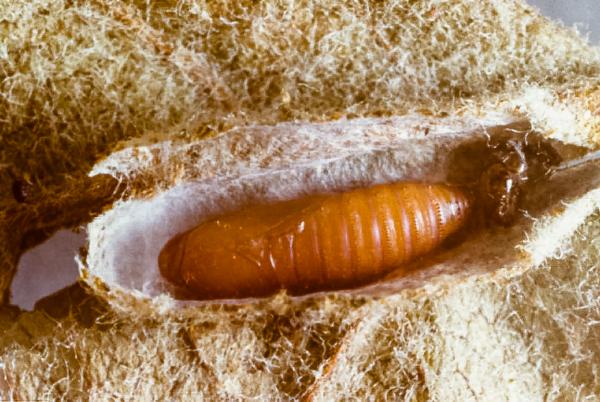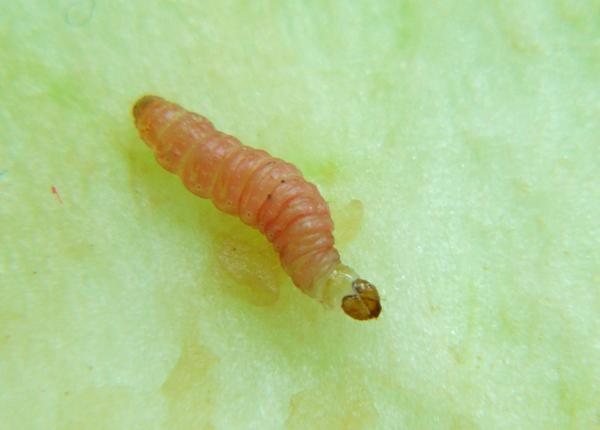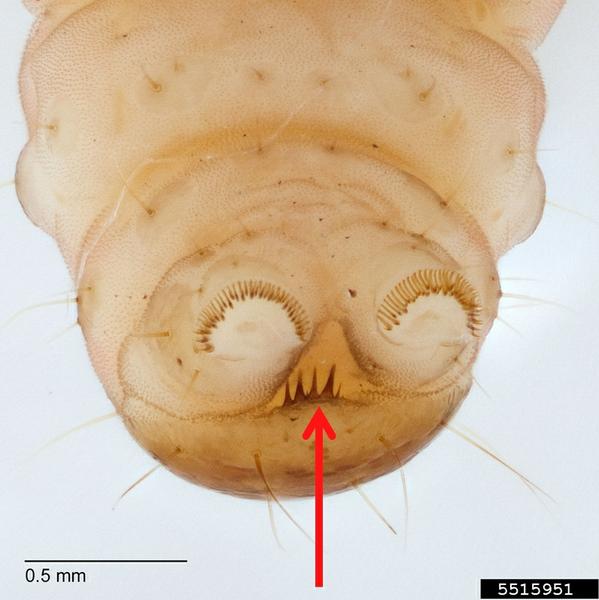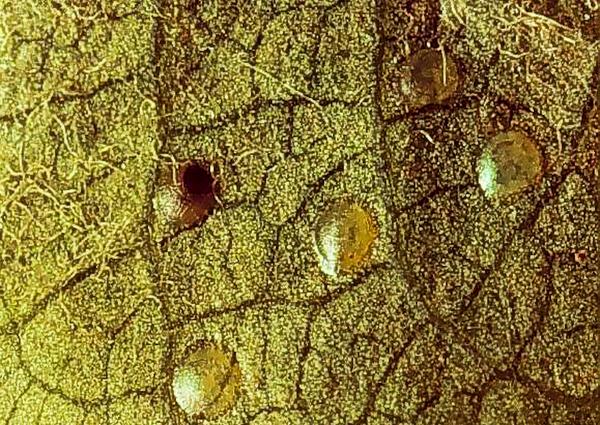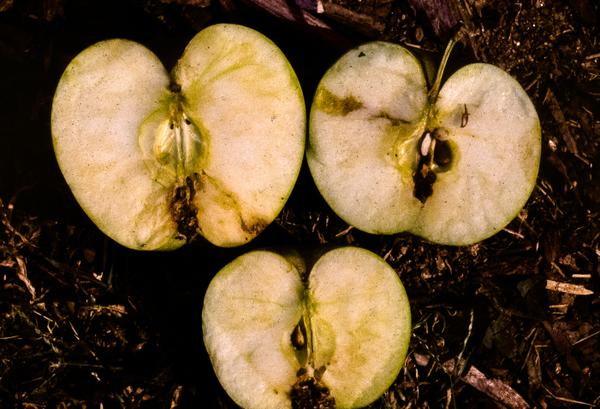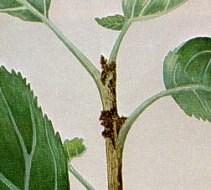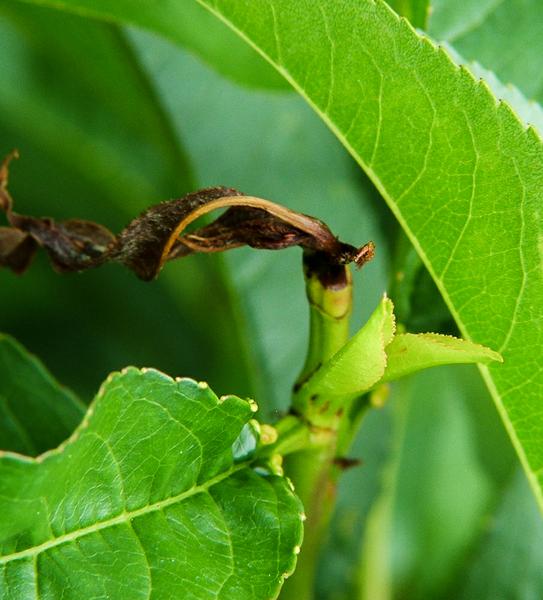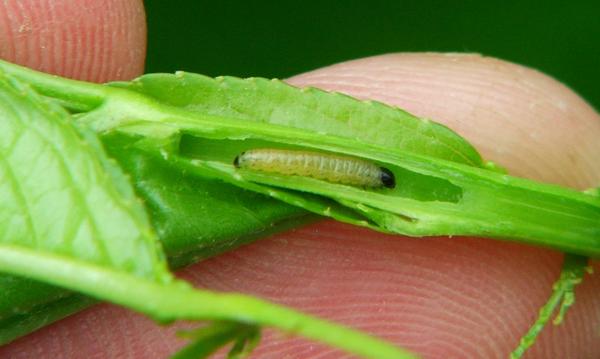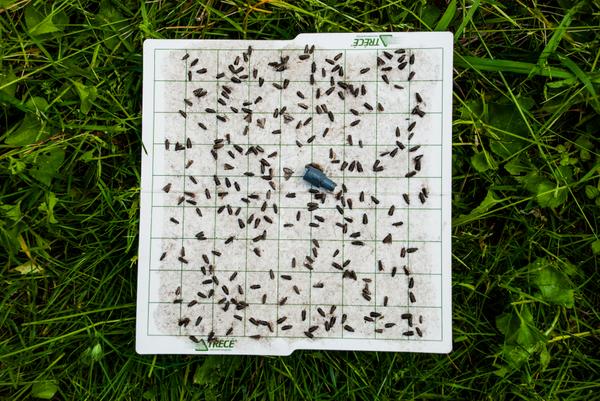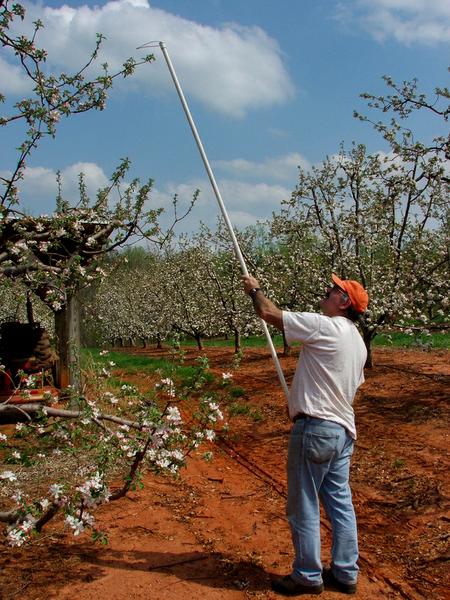Background and Description
The oriental fruit moth (Grapholita molesta; OFM) is native to China but is now found throughout much of the world. Like the codling moth, it is a member of the tortricid family and is one of the most significant lepidopterous pests of apple in North Carolina.
The adult OFM is approximately 1/4 inch (6.5mm) long and has a faint gray-brown salt-and-pepper pattern on its wings. Pupae are reddish brown. Fully developed larvae are about 1/2 inch (12.5mm) long, pink to white in color, and are very similar to codling moth larvae except for the presence of an "anal comb" structure visible only under a microscope. Eggs are about 1/32 inch (0.7mm) in diameter, yellow-white, and laid singly on leaves or twigs.
Life History
The OFM overwinters in tree bark, dead leaves, or other debris as a fully-grown larva enclosed in a cocoon. In early spring, larvae develop into pupae and emerge as adults in mid-March to early April, depending on location and weather conditions. After mating, females will lay up to 200 eggs that begin to hatch at petal fall. Larvae feed on shoot tips and inside fruit. There are typically four or five generations per season in the Southeast.
Damage
Similar to codling moth, OFM larvae bore into fruit and leave behind holes that are often filled with crumbly, brown frass (excrement). However, unlike codling moth, the tunnels they create inside the fruit often meander randomly and do not usually enter the core. OFM that are killed by insecticides can leave ‘stings’ on the exterior of the fruit. Larvae may also attack new leaf shoots, causing 'flagged' leaves and, in severe situations, stunting tree development.
Monitoring and Control
For detailed information on insect emergence times, degree-day calculations, and the most current control practices (including mating disruption and recommended insecticides), read the "Pest and Orchard Management Program," "IPM Practices for Selected Pests," and "Relative Effectiveness of Insecticides and Miticides" sections of the Integrated Orchard Management Guide for Commercial Apples in the Southeast.
Base a decision to spray insecticides against OFM on pheromone trap catches and a degree-day (DD) model. Use pheromone traps to determine the starting point of the model and to gauge the intensity of populations. Traps should be placed in orchards near the green tip stage of bud development, and checked at least two times per week. Hang traps at eye level at a density of one trap per 10 acres of orchard. The 'biofix' date is established when pheromone traps sustain a catch of two or more moths. (It is only necessary to check traps once per week after biofix is determined.) Begin to accumulate degree days at biofix.
The degree-day model predicts adult emergence and egg hatch for the first three generations of the four or five generations that occur in the Southeast. However, generations overlap in the late season, which makes the degree-day model less useful later in the season.
- First-Generation OFM: Control of the first generation is often important to prevent first-generation damage and to reduce populations of subsequent generations. First-generation egg laying is usually low on apple, and only one insecticide application between 400 and 500 DD after biofix is necessary, which usually coincides with petal fall.
- Second-Generation OFM: If first-generation control was successful, second-generation populations are usually very low. Extremely low-density orchards (where pheromone trap catches never exceed 3 moths per trap per week between 800 to 1,600 DD) may not require an insecticide application. In low-density orchards (3 to 5 moths per trap per week between 800 and 1,500 DD), make a single insecticide application at 1,400 DD. Moderate- to high-density orchards will have fruit damage, higher trap catches, or both, and may need two insecticide applications 14 days apart starting at 1,100 DD.
- Third-Generation OFM: An insecticide is recommended at 2,200 DD after biofix if pheromone trap catches exceed 5 moths per trap per week at 1,900 DD after biofix and if there is fruit damage caused by the second generation.
- Fourth-Generation OFM: Because of overlapping generations late in the season, it is difficult to predict when egg hatch of the fourth generation begins. However, continuous egg laying can occur from August through October, and pheromone traps are the best method to determine the potential for late-season damage. Apply an insecticide within 7 to 10 days of a pheromone trap threshold of 7 moths per trap per week.
Publication date: Feb. 23, 2015
Recommendations for the use of agricultural chemicals are included in this publication as a convenience to the reader. The use of brand names and any mention or listing of commercial products or services in this publication does not imply endorsement by NC State University or N.C. A&T State University nor discrimination against similar products or services not mentioned. Individuals who use agricultural chemicals are responsible for ensuring that the intended use complies with current regulations and conforms to the product label. Be sure to obtain current information about usage regulations and examine a current product label before applying any chemical. For assistance, contact your local N.C. Cooperative Extension county center.
N.C. Cooperative Extension prohibits discrimination and harassment regardless of age, color, disability, family and marital status, gender identity, national origin, political beliefs, race, religion, sex (including pregnancy), sexual orientation and veteran status.


